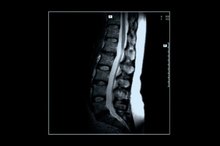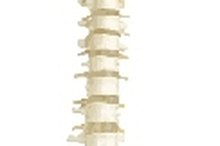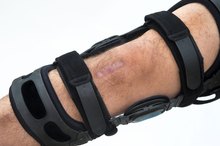What does fact checked mean?
At Healthfully, we strive to deliver objective content that is accurate and up-to-date. Our team periodically reviews articles in order to ensure content quality. The sources cited below consist of evidence from peer-reviewed journals, prominent medical organizations, academic associations, and government data.
The information contained on this site is for informational purposes only, and should not be used as a substitute for the advice of a professional health care provider. Please check with the appropriate physician regarding health questions and concerns. Although we strive to deliver accurate and up-to-date information, no guarantee to that effect is made.
Complications of Lumbar Laminectomy
A laminectomy can relieve pressure on the spinal nerves that causes pain and impairs function in the neck or back, according to the American Academy of Orthopaedic Surgeons. The surgeon removes a small piece of bone above the affected nerve and the disc under the nerve, or both, decompressing the area to allow the nerve to heal. The surgeon may also perform a spinal fusion to prevent instability.
If you are experiencing serious medical symptoms, seek emergency treatment immediately.
Complications of lumbar laminectomies, which involve the area of the spine between the neck and the small of the back, depend on the underlying cause of the pain and the general health of the patient.
Continued Pain
One of the most common complications of any spinal operation involves the patient continuing to experience pain after surgery, according to the University of Maryland Medical Center 2. Although most lumbar laminectomy patients with leg pain feel better immediately, approximately 10 to 20 percent will continue to have problems until the nerve heals, according to Peter F. Ullrich, M.D., in a Nov. 4, 2009 report published on "Spine-Health."
In fact, the trauma of the surgery may cause the pain to increase due to swelling around the nerve root, although this effect should subside within the first three months. Numbness and tingling in the leg, however, may take up to a year to resolve.
- One of the most common complications of any spinal operation involves the patient continuing to experience pain after surgery, according to the University of Maryland Medical Center 2.
- Although most lumbar laminectomy patients with leg pain feel better immediately, approximately 10 to 20 percent will continue to have problems until the nerve heals, according to Peter F. Ullrich, M.D., in a Nov. 4, 2009 report published on "Spine-Health."
Nerve Trauma
What Are the Treatments for a Vertebral Hemangioma?
Learn More
Nerve damage in lumbar laminectomy procedures occurs in about one in 1,000 cases, notes Ullrich. Nerve damage may occur when a bone fragment continues to pinch the nerve or the nerve is dissected during the procedure. Trauma during surgery can cause permanent muscle weakness or paralysis in the affected area, but this outcome is rare, according to A. Jay Khanna, M.D., in a report published by the American Academy of Orthopedic Surgeons.
Damage to the nerves that control the bowels or bladder causes incontinence, or loss of urinary control, in one out of 10,000 patients, notes Khanna. Traumatizing nerves that affect the pelvic region may cause sexual dysfunction, according to the University of Maryland Medical Center 2.
- Nerve damage in lumbar laminectomy procedures occurs in about one in 1,000 cases, notes Ullrich.
- Trauma during surgery can cause permanent muscle weakness or paralysis in the affected area, but this outcome is rare, according to A. Jay Khanna, M.D., in a report published by the American Academy of Orthopedic Surgeons.
Returning Pain
Patients with spinal stenosis, a narrowing of the spinal canal, may experience pain relief for several years after surgery followed by a return of the symptoms, according to Ullrich. In those cases, the bone may grow back at the same point or at a different portion of the spine, causing pain in the back and the leg. Pain from a recurrent herniated disk, a fluid-filled shock absorber between each pair of vertebrae in the spine, may return within three months of surgery in about 5 to 10 percent of patients.
Spinal Instability
Symptoms of Lumbar Hemangioma
Learn More
Five to 10 percent of patients undergoing lumbar laminectomy experience instability in the spine after surgery, says Khanna. The problem may be caused by continuing damage to the area from degenerative joint disease or from removing too much of the bone structure. In either case, a surgical spinal fusion may be required to restore stability and reduce pain.
Related Articles
References
- Cleveland Clinical: Surgical Treatment
- University of Maryland Medical Center: Patient's Guide to Complications of Spinal Surgery
- Spine-Health: Lumbar Decompression Back Surgery Considerations
- Berciano J, Sedano MJ, Pelayo-Negro AL, García A, Orizaola P, Gallardo E, et al.. Proximal nerve lesions in early Guillain-Barré syndrome: implications for pathogenesis and disease classification. J Neurol. 2017 Feb;264(2):221-236. doi: 10.1007/s00415-016-8204-2. Epub 2016 Jun 17.
- Matejčík V, Haviarová Z, Šteňo A, Kuruc R, Šteňo J. Intraspinal intradural variations of nerve roots. Surg Radiol Anat. 2017 Dec;39(12):1385-1395. doi: 10.1007/s00276-017-1903-2. Epub 2017 Jul 29.
Writer Bio
Marcy Brinkley has been writing professionally since 2007. Her work has appeared in "Chicken Soup for the Soul," "Texas Health Law Reporter" and the "State Bar of Texas Health Law Section Report." Her degrees include a Bachelor of Science in Nursing; a Master of Business Administration; and a Doctor of Jurisprudence.









